
¡ toros vivos ! The semiotic landscape of Murcia
Bullfights are allowed again in Spain, even in Catalonia. In the Spanish city of Murcia, Sjaak Kroon discovered some traces of the veganarchistic resistance against this example of Spanish cultural heritage.
This text was first published in Dutch
Animal abuse or cultural heritage
Recently the 2011 ban on bullfights in Catalonia, issued by the Catalan Parliament, was overruled by the Spanish Constitutional Court. This decision reflects the ongoing power struggle between the Spanish State and Catalonia. Since the Catalan ambition to separate from Spain leads them to dismiss everything of symbolic value to Spain, bullfighting became an obvious victim. The most important reason for the ban in 2011 was 'animal abuse'. Referring to such different arguments as 'artistic freedom', 'the duty to protect access to culture and cultural heritage' and 'equality of all Spanish citizens', the Partido Popular among others filed a complaint against the Catalan decision at the Constitutional Court and in 2015 bullfighting was declared immaterial cultural heritage (Bakker, 2016).
Next to Madrid and Valencia, also Murcia belonged to the regions that plead for declaring bullfighting as cultural heritage. In the city of Murcia one can find the Plaza de Toros de La Condomina, a bull ring that according to the information sign at the entrance was opened in 1887 and can host 15,000 visitors.
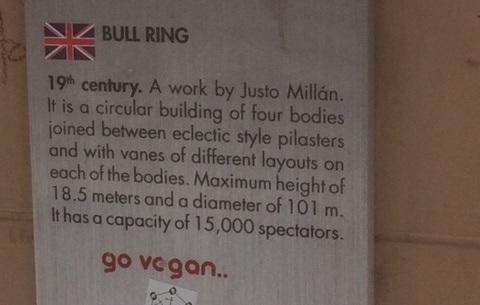
Figure 1: Information sign
In that same city of Murcia in June 2016 the 21st Sociolinguistic Symposium took place. As a visitor of that meeting, I wasn’t aware of the existence of a local Plaza de Toros, but walking from the conference site to the restaurant where the delegates were supposed to have lunch, I witnessed the impressive building. What especially took my attention were the large numbers of young people camping outside the gates – already for quite a while as was shown by the food and sleeping bags they carried with them. As a matter of fact they were waiting for the start of the ticket sales for a concert of the popular Spanish pop artist Melendi (Ramón Melendi Espin). He gave a concert in Murcia, June 17th 2016 as part of his Directo a septiembre tour – named after the tile of his life CD recorded September 19th 2015 in the Plaza de Toros de Las Vantas in Madrid.
Carne de toro in the semiotic landscape
When I crossed the road, just opposite the Plaza de Toros I saw the beautiful old butchery of Angel R. Mompéan. A rich decorated tile picture indicated that the butcher, in addition to quite some other meat products, also offered carne de toro (bull meat). Not all that strange for a butchery just opposite the arena…
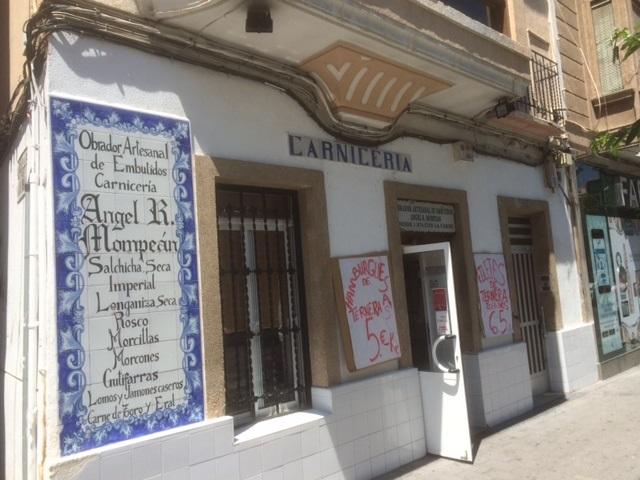
Figure 2: Angel R. Mompéan’s Carniceria
In the dead alley next to the butchery, I found a larger than life wall painting of a black bull. While I was making a picture of the painting a man stepped out who turned out to be the butcher. We engaged in a conversation and he explained that the painting had been damaged already several times by activists who campaigned against bullfighting. He was proud on his trade that clearly included the slaughtering of bulls and had the painting cleaned and restored several times. The green graffiti text sprayed next to the bull ¡ toros vivos ! (long live the bulls) and the green colored horns of the bull, according to the butcher, were the work of activists as well. These signs offered a clearly critical footnote to the bullfights that regularly took place in the arena and the sale of the victims' meat at this local butcher shop. The butcher didn’t have to say a single good word about all of this.
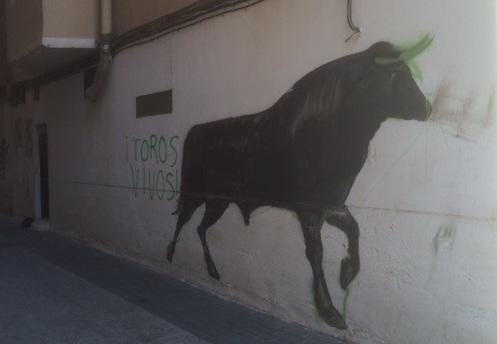
Figure 3: Long live the bulls
Mr Mompéan invited me in his shop and offered me a piece of dry sausage – porc. I then walked around the arena and observed on the pillars next to the iron gate a few more green sprayed texts against bullfighting: torero asesino / hazte veganx (bullfighter murderer / become a vegan) and ni toros en plazas / ni vagas mataderos (no bulls in the plazas / no vacancies for bullfighters). I tried to have a look in the arena itself but wasn’t allowed to enter since they were preparing for that evening’s concert. Melendi, by the way, as shown by his website, in his tour in August also performed at the Plaza de Toros in La Roda and in September at the Plaza de Toros in Valladolid. The graffiti in Murcia apparently failed to make an impression on the artist.
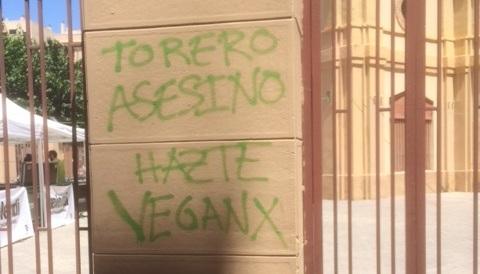
Figure 4: Bullfighter murderer, become a vegan
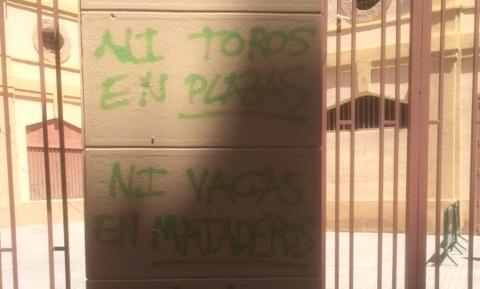
Figure 5: No bulls in the plazas, no vacancies for bullfighthers
Veganarchism and the bull as an icon
The unsuspecting passer-by could consider the wall painting of the bull and the graffiti next to the butchery of Angel R. Mompéan in Murcia as an ensemble. As a salute – ¡ toros vivos ! – to the iconic Spanish bull, the usually defeated sparring partner of the bullfighter. As the logo of the Spanish sherry brand Osborne, the bull in silhouette, fourteen meters high, still inescapably emerges in the Spanish landscape. When the Spanish Government in 1992 decided to remove all billboards from the Spanish highways, the bull was taken under the protection of cultural organizations, artists, politicians and journalists as cultural heritage. This however led to quite some controversy, especially in Catalonia that didn’t recognize this symbol of Spanish national culture.
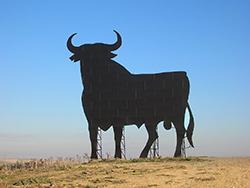
Figure 6: Osborne bull
The explanation given by my butcher provided a totally different perspective on the wall painting and the text. Not only made it clear that he had the bull put there as a salute to the very animal and to bullfighting – of course without the text ¡ toros vivos ! that was added by anti bullfight activists, conveying the meaning ‘let the bulls live’ and don’t make them a tourist attraction. The anti bullfight movement is a 'green' movement that not only campaigns against bullfighting but also calls on the public to convert to veganism: hazte veganx.
The same text, in English, is also sprayed on the information sign in Figure 1 (go vegan). Below the text in Figure 5 is a symbol in the same color green and in the same handwriting. The combination of A for Anarchism and V for Veganism together refers to the vegananarchism movement. Veganarchism (Dominick, 1997) is a political philosophy in which veganism, more specifically the fight for animal rights and the liberation of the earth, and anarchism go together and strive for a social revolution. The state, capitalism and hierarchical structures in general in that perspective are not considered to be necessary and even a threat for men and animals alike.
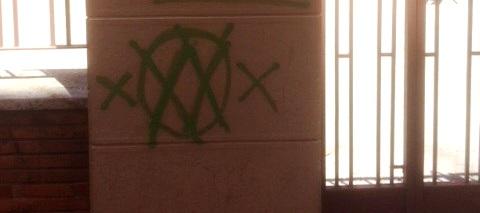
Figure 7: Veganarchism
By using the veganarchism symbol the slogans and protest against bullfighting at the same time become a broader political protest that fits the resistance against the bull as a national symbol of Spain and against the Spanish State in general.
The semiotic landscape around the Plaza de Toros in Murcia in text, color and signs reflects the Spanish dispute about the non-acceptability of bullfighting. In that dispute the ‘green’ argument of animal abuse in combination with a meat free vegan lifestyle plays a central role. The use of the veganarchist VA-symbol moreover shows that the resistance against the bull as a symbol of Spain and bullfighting as a Spanish cultural heritage is at the same time a protest against the Spanish State that facilitates and protects these practices as cultural heritage.
References
Bakker, M. (2016). Verbod op stierenvechten Catalonie ongedaan gemaakt. de Volkskrant 20-10-2016.
Dominick, B. (1997). Animal Liberation and Social Revolution: A vegan perspective on anarchism or an anarchist perspective on veganism, third edition. Chicago, Firestarter Press.